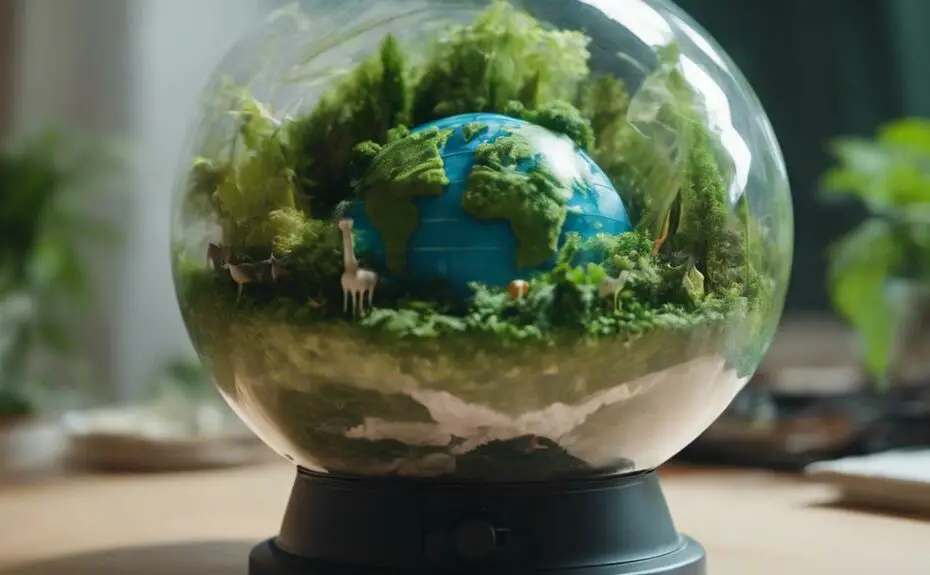Vacuum sealers have often been labeled as villains in our environmental efforts, but that characterization is too hasty. After years of careful analysis, I have come to realize that there is more to their impact than meets the eye. While it is true that vacuum sealers contribute to plastic waste and energy consumption, we cannot ignore the crucial role they play in reducing food waste, which is a significant environmental threat.
Let's start by addressing the plastic predicament. Vacuum sealers do use plastic bags or rolls to create airtight packaging, and this does contribute to our plastic waste problem. However, it's important to note that not all vacuum sealers use the same amount of plastic. Some brands offer eco-friendly options, such as reusable silicone bags or biodegradable plastic bags. By choosing these alternatives, we can significantly reduce our plastic footprint.
In terms of energy consumption, vacuum sealers do require electricity to operate. However, the energy usage is relatively low compared to other kitchen appliances. Additionally, some vacuum sealers come with energy-saving features, such as automatic shut-off or power-saving modes. By opting for these energy-efficient models, we can minimize our environmental impact.
Now, let's talk about the primary benefit of vacuum sealers: reducing food waste. Food waste is a massive environmental issue, as it contributes to greenhouse gas emissions and depletes our precious resources. Vacuum sealers help extend the shelf life of perishable foods, such as meats, fruits, and vegetables, by removing excess air and preventing spoilage. This means we can store food for longer periods without it going to waste. By using a vacuum sealer, we can save money and reduce our carbon footprint.
To illustrate this further, let's consider a specific example. Imagine you have just bought a large pack of chicken breasts, but you know you won't be able to consume them all before they spoil. By vacuum sealing the extra portions and storing them in the freezer, you can ensure their freshness for months to come. This not only prevents food waste but also reduces the need for frequent grocery shopping trips, saving you time, money, and reducing the environmental impact of transportation.
In conclusion, while vacuum sealers do contribute to plastic waste and energy consumption, their role in reducing food waste should not be overlooked. By choosing eco-friendly options and energy-efficient models, we can mitigate their environmental impact. Vacuum sealers play a vital role in extending the shelf life of perishable foods, saving us money and reducing our carbon footprint. It's essential to strike a balance between convenience and sustainability, and vacuum sealers can be a valuable tool in achieving that balance.
The Rise of Vacuum Sealers
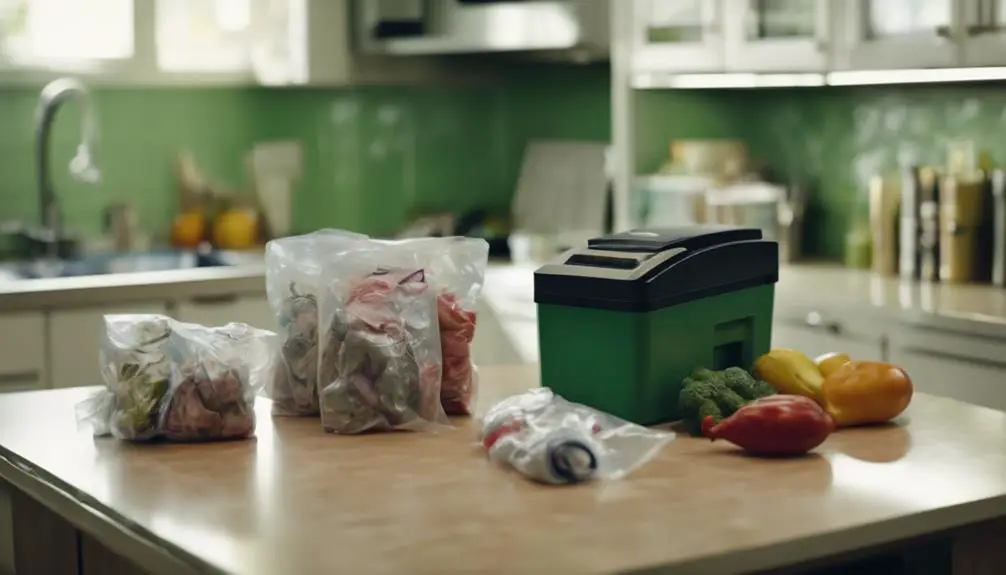
Vacuum sealers have become an essential tool in modern food preservation, transforming the way we store and protect our food. These devices have revolutionized kitchens, both at home and in professional settings, by increasing efficiency and promoting sustainability. It's crucial to recognize the significant impact vacuum sealers have on reducing food waste, which is a pressing environmental issue.
Food waste extends beyond what we throw away on our plates. It also encompasses the energy, water, and resources wasted in producing food that never gets consumed. Vacuum sealers directly address this problem by extending the shelf life of food. This not only saves money but also conserves resources and respects the effort that goes into food production.
The rise of vacuum sealers reflects a growing awareness and commitment to sustainability. While some may dismiss them as just another kitchen gadget, I see them as a vital tool in our fight against waste. They demonstrate human ingenuity in adapting technology for environmental stewardship. Far from being wasteful, vacuum sealers play a crucial role in our journey towards more sustainable living.
By using vacuum sealers, we can significantly reduce food waste and contribute to a more sustainable future. These devices aren't only practical but also eco-friendly. They help us make the most of our food, saving resources and respecting the hard work that goes into its production. Investing in a vacuum sealer is a step towards a more efficient and responsible way of preserving food.
One highly recommended vacuum sealer is the FoodSaver V4400 2-in-1 Vacuum Sealer Machine. It offers various sealing options and can handle both wet and dry foods. This versatile device ensures airtight packaging, extending the shelf life of your food and reducing waste. Another excellent option is the NutriChef Vacuum Sealer. It's compact, user-friendly, and provides reliable sealing for your food items. Whichever vacuum sealer you choose, you'll be making a positive impact on both your wallet and the environment.
How Vacuum Sealers Work
Understanding how vacuum sealers work is essential because these devices have a significant impact on reducing food waste and promoting environmental sustainability. Let me explain their operation in a simple and straightforward manner:
Firstly, the vacuum sealer removes all the air from the bag or container. This step is crucial because it eliminates oxygen, which is responsible for the degradation of food. By doing so, vacuum sealers effectively extend the freshness and shelf life of the food.
Once the air is expelled, the opening of the bag is sealed with heat. This sealing process creates a barrier that prevents air from re-entering the bag, ensuring that the food remains fresh and protected.
What makes vacuum sealers even more convenient is that many models offer customizable settings. These settings allow users to adjust the vacuum level and sealing time based on the type of food and packaging materials being used. This flexibility ensures that different types of food can be properly sealed and preserved.
Some vacuum sealers also come with attachments for sealing containers and jars, adding to their versatility. This means you can use the sealer to preserve not only food in bags but also leftovers in containers or even homemade sauces in jars.
To make the sealing process even easier, many vacuum sealers have indicator lights or beeps. These features guide users through the process, ensuring that the sealing is done correctly and efficiently.
Using vacuum sealers isn't just about saving food; it's about showing respect for our resources and reducing waste. By using these devices, we can manage our food more efficiently and reduce our impact on the environment. The operation of vacuum sealers demonstrates human ingenuity in our pursuit of sustainability.
If you're looking for a vacuum sealer, I recommend considering models like the FoodSaver V4840 2-in-1 Vacuum Sealer or the NutriChef Vacuum Sealer. These models offer excellent sealing capabilities and customizable settings, making them perfect for preserving different types of food.
Benefits of Food Preservation
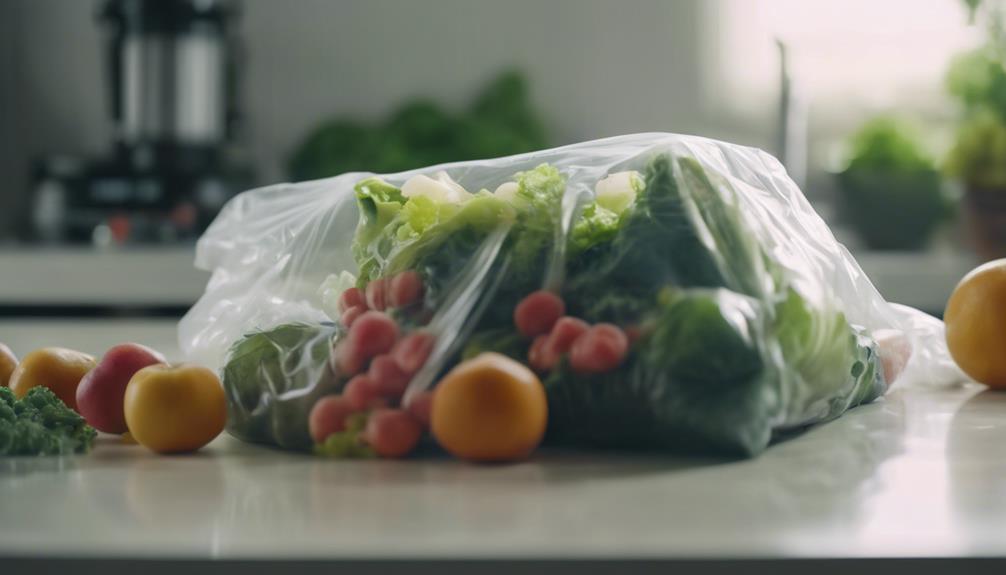
Preserving food through vacuum sealing is a crucial tool in our fight against waste, promoting sustainability and responsible resource management. It's a method that I wholeheartedly embrace, understanding its vital role in reducing food waste, a pressing global issue. Vacuum sealing significantly extends the shelf life of food, directly combating the prevalent throwaway culture that plagues our society. It's not just about saving leftovers; it's a powerful statement of our commitment to a more sustainable lifestyle.
One of the key benefits of vacuum sealing is its ability to triple the lifespan of food products. By removing air and sealing the food in an airtight bag, vacuum sealing creates an environment that inhibits the growth of bacteria and fungi. This means that food stays fresh for much longer, reducing the likelihood of spoilage and waste. By extending the shelf life of our food, we can make a significant impact on reducing the amount of food that ends up in landfills.
The reduction of food waste isn't just environmentally significant; it also has economic benefits. By preserving food through vacuum sealing, we can save money by reducing the need for frequent shopping trips. With longer-lasting food, we can buy in bulk, take advantage of sales, and avoid the need to throw away unused portions. This economic efficiency not only benefits our wallets but also contributes to a more sustainable use of resources.
These benefits aren't just abstract concepts; they've a tangible impact on our environment and our lives. Through vacuum sealing, I'm not only choosing a better method of food preservation, but I'm also advocating for a greener, more sustainable world. It's a practical and effective measure that aligns with the values of those who strive to make a difference.
To illustrate the power of vacuum sealing, let's consider an example. Imagine having a delicious homemade stew that you want to enjoy over the course of a week. By vacuum sealing the stew and storing it in the refrigerator, you can ensure that it stays fresh and flavorful for the entire week. Without vacuum sealing, the stew would likely spoil within a few days, leading to waste and the need to prepare a new batch. This example highlights how vacuum sealing can save both food and money, making it a valuable tool in our efforts to reduce waste.
Environmental Costs of Plastic Use
While I understand and appreciate the benefits of vacuum sealing for food preservation, it's crucial to acknowledge the environmental impact of increased plastic use that comes with it. The production and disposal of plastic have significant environmental concerns that we can't ignore. Let's delve deeper into these issues:
One major concern is that most plastics used in vacuum sealing are non-biodegradable. This means that they can persist in landfills for centuries, contributing to long-term environmental degradation.
Another issue is the potential for marine pollution. If plastic waste isn't properly managed, it can find its way into oceans and pose a threat to marine life. This is a significant problem that we must address.
Additionally, the production of plastic is resource-intensive and relies heavily on fossil fuels. This not only contributes to carbon emissions but also perpetuates our dependence on non-renewable resources.
Furthermore, the recycling of vacuum seal plastics can be challenging. Not all types of plastic used in this process are easily recyclable, which complicates efforts to minimize waste and promote a circular economy.
Lastly, certain types of plastics used in vacuum sealing have the potential to leach harmful chemicals into the soil and waterways. This poses a risk to ecosystems and further highlights the need for sustainable alternatives.
Despite these environmental concerns, I firmly believe in advocating for responsible use and disposal of plastics. It's crucial to strike a balance between the benefits of food preservation and the environmental impact of plastic use.
In order to minimize the environmental cost, it's important to explore more sustainable materials for vacuum sealing. There are alternatives available, such as reusable silicone bags or beeswax wraps, that can help reduce our reliance on plastic. These options not only provide an eco-friendly alternative but also offer effective food preservation.
Energy Consumption Analysis
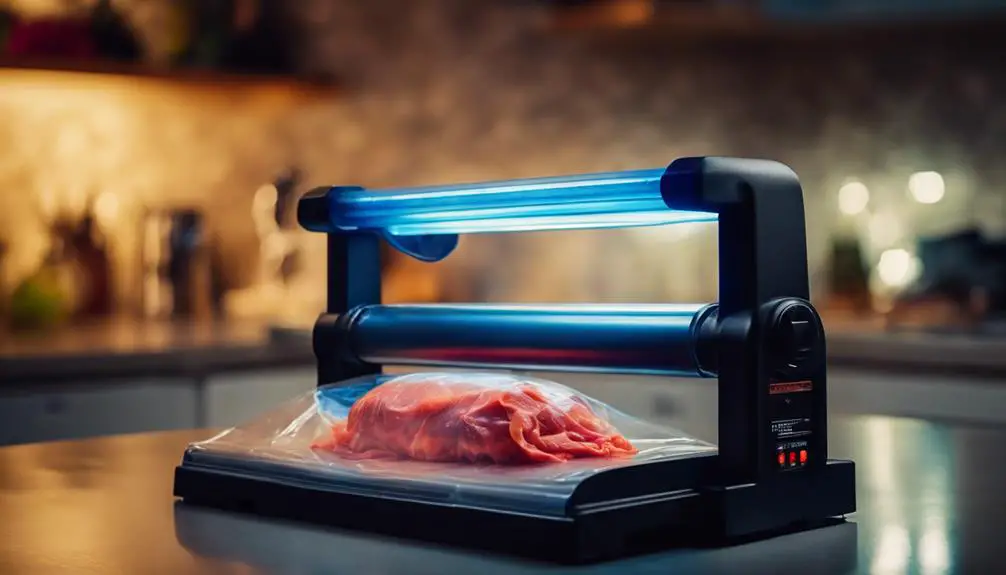
When considering the environmental impact of vacuum sealing, it's crucial to also examine the energy consumption involved. While plastic waste is a significant concern, we mustn't overlook the energy footprint of vacuum sealers. Scrutinizing every aspect of our daily practices is essential, even those that may seem insignificant but have cumulative effects over time.
Compared to other kitchen appliances, the energy consumption of vacuum sealers is relatively low. It's important to put this into perspective. Vacuum sealing food not only extends its shelf life but also actively reduces food waste. This often gets overlooked in discussions about energy use. By reducing waste, we decrease the need for resources to produce, transport, and store new food items, resulting in a significant decrease in overall energy consumption.
While concerns about energy use are valid, it's crucial to recognize the broader environmental benefits that come with using vacuum sealers responsibly. By focusing solely on their energy consumption without acknowledging their role in reducing food waste, we miss a crucial part of the story.
Alternatives to Traditional Vacuum Sealers
Exploring alternatives to traditional vacuum sealers is essential for our commitment to environmental sustainability. We can't ignore the innovative solutions that contribute to a greener future. It's time to embrace alternatives that not only match the efficiency of traditional sealers but also significantly reduce our ecological impact.
One promising alternative is silicone bags. These bags are reusable, durable, and perfect for sous vide cooking. They're a versatile and eco-friendly addition to any kitchen.
Glass containers with sealing lids are another excellent option. They're ideal for meal prepping and storing food. By choosing glass containers over single-use plastics, we can make a sustainable swap that reduces waste.
Beeswax wraps are a natural and eco-friendly alternative to vacuum sealers. With their natural adhesive, they conform to the shape of your food or container, keeping items fresh without creating unnecessary waste.
Fabric pouches with airtight seals are great for storing dry goods. These pouches offer a quaint and plastic-free storage solution that's both practical and environmentally friendly.
For those looking for a long-lasting investment, stainless steel containers with vacuum lids are a great choice. These containers are strong, durable, and can help reduce the need for single-use plastics in the kitchen.
These alternatives represent a step forward in our journey towards reducing our environmental impact. By choosing them, we're actively participating in the change we want to see. It isn't just a statement; it's a commitment to the future of our planet.
Impact on Waste Reduction
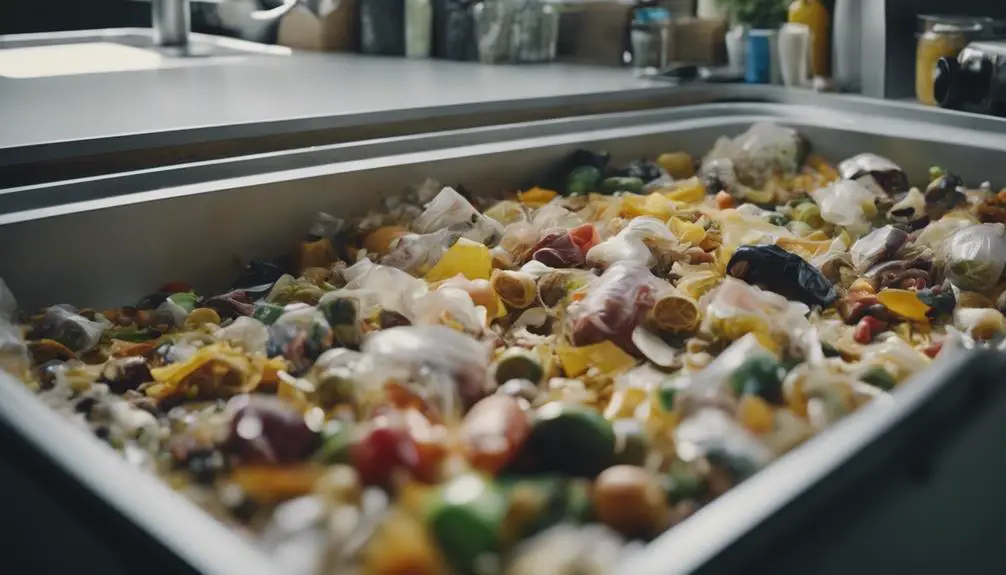
Let's not underestimate the crucial role that waste reduction plays in protecting our planet's future. Vacuum sealers, when used wisely, are more than just convenient gadgets. They're powerful tools in the fight against food waste. I've personally seen how these devices can revolutionize the way we store food, significantly prolonging its shelf life and reducing the amount of food that ends up in landfills. Just think about the potential impact of slashing the 1.3 billion tons of food wasted globally each year. It's truly compelling.
Some critics argue that the plastic bags used in vacuum sealing contribute to plastic waste. However, they're missing the bigger picture. Consider the alternative: throwing away large quantities of food, which not only wastes valuable resources but also produces methane, a potent greenhouse gas, as it decomposes. In comparison, the impact of these specialized bags seems minimal, especially when you consider that they can be recycled and that more sustainable materials are being developed.
I'm not claiming that vacuum sealers are the ultimate solution to our waste problems. However, I firmly believe that their contribution to waste reduction is too significant to ignore. They represent a step in the right direction and are a vital piece of the puzzle in creating a more sustainable world.
To make it simpler, vacuum sealers are powerful tools that can greatly reduce food waste. By extending the shelf life of stored food, they help prevent it from ending up in landfills. Considering the staggering amount of food wasted globally, it's clear that the impact of vacuum sealers is significant. While some critics argue that the plastic bags used in vacuum sealing contribute to plastic waste, the alternative of throwing away food is far worse. Not only does it waste resources, but it also produces harmful greenhouse gases. In comparison, the impact of the bags is minimal, especially when they can be recycled and more sustainable materials are being developed. While vacuum sealers aren't a complete solution to waste, they're an important step towards a more sustainable future.
Balancing Convenience and Sustainability
Finding the right balance between convenience and sustainability is crucial when it comes to vacuum sealers. These devices play a significant role in reducing food waste, but we must also ensure that they align with our sustainability goals without sacrificing convenience. It may seem like a difficult task, but I firmly believe that with careful consideration, we can achieve this balance successfully.
One way to make vacuum sealers more sustainable is by opting for biodegradable bags. We can't ignore the plastic problem, but by switching to biodegradable options, we can significantly reduce our environmental footprint. These bags break down naturally over time, mitigating the harm caused by traditional plastic bags.
Investing in durable machines is another essential aspect of sustainability. By choosing high-quality, long-lasting vacuum sealers, we minimize electronic waste. It's about valuing quality over quantity and ensuring that our devices have a longer lifespan.
Energy efficiency is key when it comes to reducing our overall energy consumption. Modern vacuum sealer models now exist that are designed to be energy-efficient. By choosing these models, we can make a significant difference in our environmental impact.
In addition to the products we choose, how we use them is also crucial. Being mindful of our usage and sealing only what's necessary helps avoid unnecessary waste. It's about being strategic and thoughtful in our approach.
Community education is another powerful tool for sustainability. By sharing knowledge and best practices on sustainable vacuum sealing, we can create a ripple effect. Educating others amplifies our impact and encourages more people to make informed decisions.
I understand the concerns raised about the environmental impact of vacuum sealers. However, I firmly believe that with thoughtful choices and responsible use, these devices can align with our sustainability objectives. It's not about shunning innovation but rather making informed decisions that prioritize both convenience and sustainability. By considering the factors mentioned above and making conscious choices, we can ensure that vacuum sealers contribute positively to our sustainability goals.
Frequently Asked Questions
How Do the Materials Used in Vacuum Sealer Bags Compare to Other Food Storage Options in Terms of Biodegradability?
Vacuum sealer bags are not as biodegradable as other options like beeswax wraps. This is frustrating because we are trying to reduce waste, but these bags do not break down easily. Beeswax wraps, on the other hand, are made from natural materials such as cotton fabric coated with beeswax, jojoba oil, and tree resin. These wraps are biodegradable and can be composted after use.
One reason why vacuum sealer bags are not as biodegradable is because they are typically made from multiple layers of plastic. These layers are designed to provide a barrier against air and moisture, which helps to preserve the freshness of the food. However, this also means that the bags are not easily broken down by natural processes.
In contrast, beeswax wraps are made from natural materials that can easily biodegrade. They are also reusable, which further reduces waste. Simply wash them with mild soap and cool water after each use, and they are ready to be used again. Beeswax wraps can last for up to a year with proper care, making them a sustainable and eco-friendly alternative to vacuum sealer bags.
In addition to beeswax wraps, there are other biodegradable food storage options available. For example, silicone food storage bags are a popular choice. These bags are made from food-grade silicone, which is a non-toxic and eco-friendly material. They are reusable, easy to clean, and can be safely used in the freezer, microwave, and dishwasher.
Another option is glass containers with airtight lids. Glass is a natural and recyclable material that does not leach harmful chemicals into food. Glass containers are durable, stain-resistant, and can be used to store both wet and dry ingredients. They are also microwave and oven safe, making them a versatile choice for food storage.
Can Vacuum Sealing Technology Be Adapted to Utilize More Sustainable or Recyclable Materials Without Compromising Its Efficiency?
Vacuum sealing technology has the potential to adopt more sustainable materials without compromising its efficiency. While critics may argue against the feasibility of this idea, advancements in biodegradable and recyclable materials indicate that we are moving in the right direction.
One of the key benefits of vacuum sealing technology is its ability to extend the shelf life of food, reducing food waste. By sealing food in airtight packaging, the risk of spoilage and contamination is significantly reduced. However, the current use of plastic materials in vacuum sealing can contribute to environmental pollution.
To address this issue, researchers and innovators are actively exploring alternative materials that are more sustainable and recyclable. For example, there are now biodegradable plastic options available that break down naturally over time, reducing their impact on the environment. These materials can be used in vacuum sealing technology, providing a more eco-friendly solution.
Additionally, advancements in material science have led to the development of compostable packaging materials. These materials are made from renewable resources and can be broken down into organic matter, which can then be used as nutrient-rich compost. By incorporating such materials into vacuum sealing technology, we can further minimize the environmental footprint of this process.
It's important to note that sustainability is not the only consideration when it comes to vacuum sealing technology. Efficiency and effectiveness are equally important. Manufacturers need to ensure that any changes made to the materials used in vacuum sealing do not compromise the key functions of this technology. However, with ongoing research and development, it is possible to find sustainable materials that meet these requirements.
To encourage the adoption of more sustainable vacuum sealing materials, governments and regulatory bodies can play a crucial role. They can incentivize manufacturers to invest in research and development, provide grants for sustainable packaging solutions, and enforce stricter regulations on the use of non-recyclable materials.
What Are the Implications of Vacuum Sealer Usage on Local Waste Management Systems and Landfill Capacities?
Vacuum sealer usage puts a significant strain on our local waste management systems and fills up landfills much faster. This is a pressing issue that requires immediate attention to protect the health of our planet.
To address this problem, we need to promote alternative methods that do not contribute to waste and landfill capacities. One such alternative is the use of reusable containers and bags. These can be easily cleaned and used multiple times, reducing the need for single-use packaging.
Another option is to encourage the use of compostable packaging materials. These materials break down naturally and do not contribute to landfill waste. By choosing products with compostable packaging, we can reduce the burden on waste management systems.
It's also important to educate consumers about the environmental impact of vacuum sealer usage. Many people may not be aware of the consequences of their actions. By providing information and raising awareness, we can empower individuals to make more sustainable choices.
Transitioning to more sustainable practices requires collaboration between consumers, businesses, and local governments. We need to work together to develop and implement effective waste management strategies that can handle the increased volume of waste generated by vacuum sealer usage.
One specific product recommendation is the use of silicone food storage bags. These bags are reusable, durable, and easy to clean. They provide a great alternative to single-use plastic bags and help reduce waste.
Are There Any Innovative Startups or Companies That Are Working on Eco-Friendly Adaptations of Vacuum Sealer Technology?
I recently came across some exciting startups that are revolutionizing the vacuum sealer industry by focusing on eco-friendly adaptations and using biodegradable materials. These companies are not just reducing waste; they are rewriting the narrative and showing that it is possible to have eco-friendly solutions without sacrificing modern conveniences.
One such startup that caught my attention is GreenSeal. They have developed a vacuum sealer that uses biodegradable bags made from plant-based materials. These bags are not only environmentally friendly but also provide the same level of sealing and freshness as traditional plastic bags. GreenSeal's commitment to sustainability extends beyond their product, as they also prioritize ethical sourcing and responsible manufacturing practices.
Another innovative company in this space is EarthPack. They have taken a unique approach by designing a vacuum sealer that incorporates recycled materials. Their machine is not only efficient in sealing and preserving food but also reduces the demand for new plastic production. With EarthPack, you can feel confident that you are making a positive impact on the environment while enjoying the benefits of vacuum-sealed food.
What sets these startups apart is their dedication to creating eco-friendly adaptations without compromising on performance or convenience. By using biodegradable or recycled materials, they are addressing the pressing issue of plastic waste while still providing a practical solution for preserving food.
These companies understand the importance of context and the need for sustainable alternatives in our modern society. They are leading the way in promoting a more environmentally conscious approach to vacuum sealing technology.
How Do Consumer Behaviors Regarding Vacuum-Sealed Products Correlate With Broader Environmental Awareness and Sustainability Practices?
Consumer behaviors regarding vacuum-sealed products often reflect their broader environmental awareness and sustainability practices. Those who prioritize sustainability are more likely to choose eco-friendly options, demonstrating a strong correlation between consumer behavior and environmental consciousness.
People who are environmentally conscious understand the importance of reducing waste and minimizing their carbon footprint. They recognize that vacuum-sealed products can help in this regard by prolonging the shelf life of perishable items, reducing food waste, and limiting the need for excessive packaging. By opting for vacuum-sealed products, these consumers actively contribute to sustainable practices.
For instance, instead of purchasing single-use plastic bags for storing food, environmentally aware individuals may choose reusable silicone or glass vacuum-sealed containers. These containers not only keep food fresh for longer but also eliminate the need for disposable plastic, thus reducing plastic waste.
Furthermore, environmentally conscious consumers might prefer vacuum-sealed products made from sustainable materials such as biodegradable or compostable films. These films are designed to break down naturally over time, minimizing their impact on the environment.
In addition to choosing eco-friendly materials, consumers who prioritize sustainability may also consider the energy efficiency of vacuum-sealed products. They recognize that some vacuum sealers consume less energy than others, contributing to overall energy conservation efforts. By selecting energy-efficient models, these consumers actively reduce their environmental impact.
Transitioning to a more sustainable lifestyle requires making conscious choices in everyday habits, including the products we use. Vacuum-sealed products offer an opportunity to align consumer behavior with environmental awareness. By selecting eco-friendly options and considering the broader impact of their choices, individuals can contribute to a more sustainable future.
To support sustainable choices, numerous brands offer vacuum-sealed products that prioritize environmental consciousness. For example, brand X specializes in vacuum-sealed containers made from recycled materials, providing a convenient and eco-friendly option for consumers. Brand Y offers vacuum sealers with energy-saving features, allowing users to reduce their energy consumption while preserving the freshness of their food.
Conclusion
I find myself standing at the intersection of innovation and tradition, contemplating the delicate balance of sustainability. Vacuum sealers, my guilty pleasure, entice with promises of freshness and longevity, yet their plastic embrace and energy consumption cast a shadow. However, there's hope on the horizon! Alternatives twinkle like stars in the night sky, guiding us toward a greener tomorrow. We've the power to be resourceful rather than wasteful, finding the sweet spot between convenience and our sacred duty to the planet. Let's make wise choices.
When it comes to the environmental impact of vacuum sealers, it's important to consider their plastic usage. These devices rely on plastic bags or rolls to create an airtight seal, which can contribute to plastic waste. However, this doesn't mean we should dismiss vacuum sealers altogether. There are eco-friendly alternatives available that can help mitigate this issue.
One such alternative is silicone storage bags. These reusable bags are made from food-grade silicone and provide airtight seals just like traditional vacuum-sealed bags. They're durable, easy to clean, and can be used over and over again, reducing the amount of plastic waste generated. Additionally, silicone is a more sustainable material compared to traditional plastics, as it's derived from silica, a natural resource.
Another option to consider is beeswax wraps. These wraps are made from organic cotton infused with beeswax, jojoba oil, and tree resin. They can be used to wrap food items and create a seal, keeping them fresh for longer. Beeswax wraps are a great alternative to plastic wrap and can be reused for up to a year. They're biodegradable and compostable, making them a more sustainable choice.
In terms of energy consumption, vacuum sealers do require electricity to operate. However, there are energy-efficient models available on the market. Look for vacuum sealers with energy-saving features such as automatic shut-off or low power consumption. Additionally, consider using solar-powered chargers or renewable energy sources to power your vacuum sealer, further reducing its environmental impact.
It's important to note that vacuum sealers can help reduce food waste, which is a significant contributor to greenhouse gas emissions. By sealing food items in airtight bags or containers, vacuum sealers help preserve their freshness and extend their shelf life. This can prevent food spoilage and encourage more mindful consumption.
In conclusion, while vacuum sealers may have some environmental drawbacks, there are ways to mitigate their impact and make more sustainable choices. By opting for eco-friendly alternatives, such as silicone storage bags or beeswax wraps, and choosing energy-efficient models, we can minimize plastic waste and reduce energy consumption. Additionally, vacuum sealers can play a role in reducing food waste, which is crucial for mitigating climate change. Let's embrace the opportunities for a greener future and make conscious decisions that benefit both our convenience and the health of our planet.
